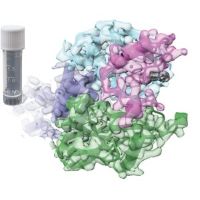Specification
| Organism | Homo sapiens (Human) |
| Expression Host | E.coli |
| Tag Info | Tag-Free |
| Purity | Greater than 95% as determined by SDS-PAGE. |
| Uniprot ID | P05019 |
| Uniprot Entry Name | |
| Gene Names | IGF1 |
| Alternative Names | Insulin-Like Growth Factor I; IGF-I; Mechano Growth Factor; MGF; Somatomedin-C; IGF1; IBP1 |
| Expression Region | Full Length of Mature Protein (49-118aa) |
| Molecular Weight | 9.1 kDa |
| Endotoxin | Less than 0.5 EU/µg as determined by LAL method. |
| Sequence | GPETLCGAELVDALQFVCGDRGFYFNKPTGYGSSSRRAPQTGIVDECCFRSCDLRRLEMYCAPLKPAKSA |
| Product Form | Lyophilized powder (Lyophilized from a 0.2 μm Filtered 20 mM NaAc-Hac, pH 4.5) |
| Reconstitution | Please reconstitute protein in deionized sterile water and we recommend that briefly centrifuge thevial prior to opening the vial .We recommend aliquot for long-term storage at -20℃/-80℃. |
Background
| Relevance | Insulin-like growth factor I (IGF1) belongs to the family of insulin-like growth factors that are structurally homologous to proinsulin. Mature IGFs are generated by proteolytic processing of inactive precursor proteins, which contains the N- and C-terminal propeptide regions. Mature human IGF-I consisting of 70 amino acids has 94% identity with mouse IGF-I and exhibits cross-species activity. IGF-1 binds IGF-IR, IGF-IIR, and the insulin receptor and plays a key role in cell cycle progression, cell proliferation and tumor progression. IGF-1 expression is regulated by growth hormone. R3 IGF-1 is an 83 amino acid analog of IGF-1 comprising the complete human IGF-1 sequence with the substitution of an Arg (R) for the Glu(E) at position three, hence R3, and a 13 amino acid extension peptide at the N terminus. R3 IGF-1 has been produced with the purpose of increasing biological activity. R3 IGF-1 is significantly more potent than human IGF-I in vitro. |
| Function | The insulin-like growth factors, isolated from plasma, are structurally and functionally related to insulin but have a much higher growth-promoting activity. May be a physiological regulator of [1-14C]-2-deoxy-D-glucose (2DG) transport and glycogen synthesis in osteoblasts. Stimulates glucose transport in bone-derived osteoblastic (PyMS) cells and is effective at much lower concentrations than insulin, not only regarding glycogen and DNA synthesis but also with regard to enhancing glucose uptake. May play a role in synapse maturation |
| Involvement in disease | Insulin-like growth factor I deficiency (IGF1 deficiency) |
| Subcellular Location | Secreted |
| Protein Families | Insulin family |
| Tissue Specificity | |
| Pathway | HIF-1signalingpathway |
QC Data
| Note | Please contact us for QC Data |
| Product Image (Reference Only) |  |

